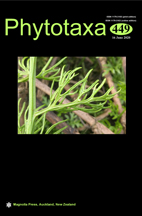Abstract
During a search for populations of wild common bean, namely south of the Central Valley of Costa Rica, a new bean species, Phaseolus albicarminus, has been found on the slope of a mountainous range named Cerros Llano Bonito in the western part of Talamanca range, where it appears to be endemic. Its main morphological features are: short pseudoracemes with four small deltoid primary bracts, small early caducous deltoid bracteoles, calyx lobes reduced to two lips, white wings contrasting with carmine purple inner face of standard, and smoothly curved 3–4 seeded pods with prow-shaped beak. The differences with apparently closely related species, P. hygrophilus and P. angucianae, are: in primary bracts (orbicular versus oval acuminate), larger bracteoles (cordate versus rounded), inner face of standard (pale pink to white versus purple), lower calyx lobes (rounded versus triangular), and pod dorsal suture (straight versus sigmoid), respectively. The fact that to date only three populations of P. albicarminus are known from the same small area of Costa Rica, calls for monitoring its conservation status. This new species is tentatively assigned to the section Brevilegumeni which seems well represented in Costa Rica (with five out of six taxa).

